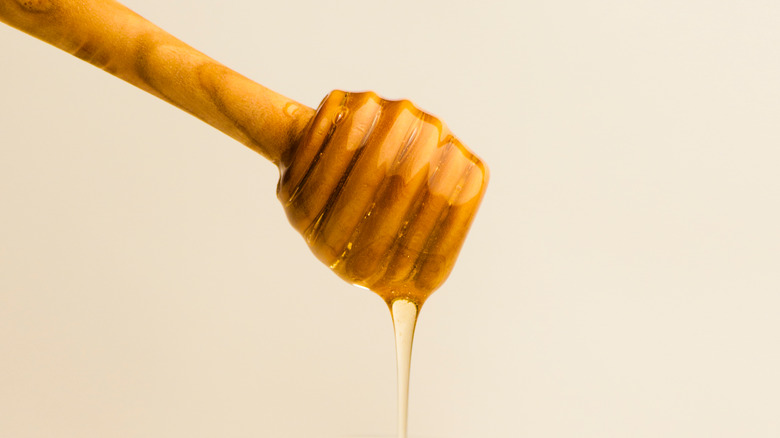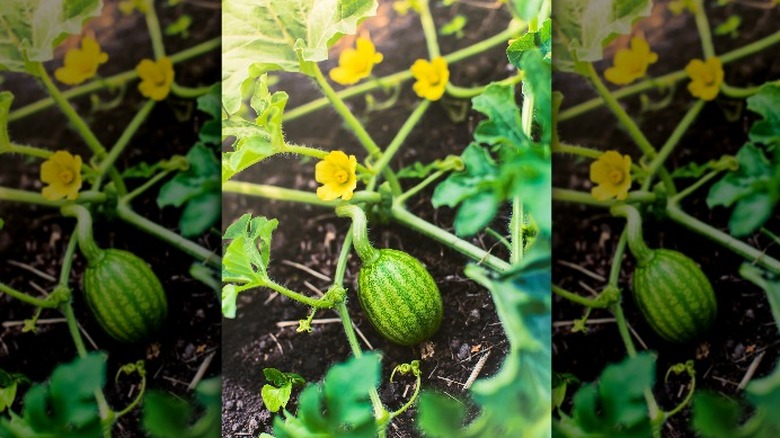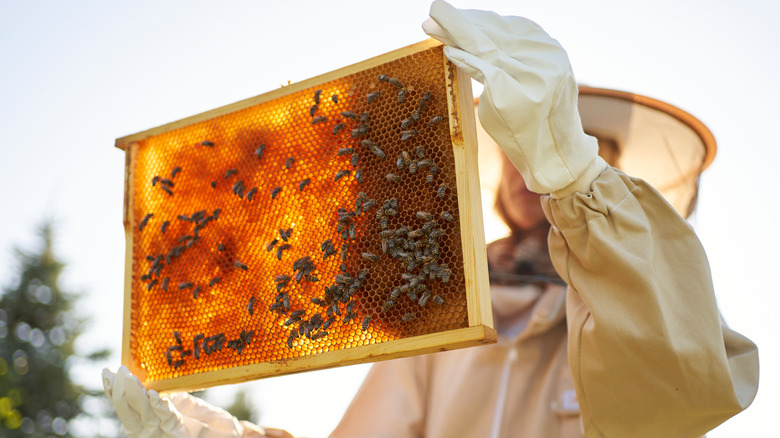Experiment With Watermelon Honey For A Rush Of Nostalgic Flavor
Beyond the buttery and spiced tupelo or the tropical-tasting Pitcairn honey, there's another unique variety that boasts one-of-a-kind flavors, served with a hint of sentimentality. Introducing ... the very whimsical sounding (and equally whimsical tasting) watermelon honey.
Also known as watermelon blossom honey, the subtly red-tinged liquid tastes and even smells faintly of juicy melons — you can thank bees with excellent taste for that. Refreshingly familiar, the sweet and summery honey seems to recall the magic of childhood and all its culinary vices, captured in one fruity, candy-coated drizzle.
While it can technically be produced wherever watermelons grow, a honey this special isn't always so straightforward to craft. A labor of love and dedication, watermelon honey can be tricky to track down, but we'd like to think that's what makes it even sweeter tasting. Like a sugary blast from the past, watermelon honey is too intriguing not to discover for yourself.
The making of watermelon honey
Even though you may have seen recipes for infused honey syrups, make no mistake, watermelon honey doesn't actually contain any fruit. Instead, the honey gets its flavor depending on where a cohort of bees gets its nectar. In the case of watermelon honey, beekeepers simply place hives near an abundance of flowering watermelon blossoms. Since bees have floral fidelity, they keep returning to the blossoms the hive favors, ensuring a monofloral honey.
Like all varieties, the process of converting nectar to honey remains the same. When bees collect nectar from a flower, it's stored in a special pouch where it mixes with enzymes. Returning to the hive, the nectar is then swapped between other honeybees where it continues to break down and eventually thicken enough to be stored in a honeycomb. The constant flapping of the bees' wings causes the honey to evaporate further, before hive cells are eventually capped with beeswax — a measure taken to ration honey as a food source for bees when flowers aren't in bloom. And it's at this point beekeepers can harvest the liquid gold.
After extracting the sweet stuff (often with the help of a centrifugal machine), the peachy-hued watermelon honey is left to settle. Next, it receives different stages of filtering before being bottled and sold.
The best ways to use watermelon honey
With a delicately fragrant and fruity aroma, the honey smells faintly of all things fresh and summery, but namely slices of juicy watermelon. On the palate, the honey tastes just as refreshing as it smells. Wonderfully sweet, it has a discretely familiar flavor; it tastes almost like a handful of Swedish Berries (or Swedish Fish!) — you know, the berry-flavored gummies you snacked on as a kid.
While there's nothing stopping you from enjoying a spoonful of the nostalgic nectar on its own like candy or spread onto a piece of just-baked bread, there are a myriad of more "grown-up" ways to indulge in the honey, starting with an elevated grazing board. Perfectly paired with sharp cheeses and spicy cured meats, the candied quality of the honey creates a sense of balance. Alternatively, make watermelon honey the star of any condiment that's in need of floral sweetness whether that be marinades for meat or vinaigrettes for roasted vegetables and salads. You can even craft a watermelon hot honey!
For those with a sweet tooth, the juicy honey can shine in baked goods like cakes and crumbles. It can even be whisked into whipped cream and frostings to impart a delicate fruitiness. Additionally, a drizzle of watermelon honey can also complement fresher fare like chilled gelato or fruit salad. Not to mention that the honey can also be used to make a simple syrup, perfect for stirring into summery cocktails.
A honey that's unlike any other
Like most single-varietal honeys, the thing that makes watermelon honey so unique is that it's produced by bees that forage from one specific floral source, a flowering watermelon plant. However, what's especially unique about watermelon blossoms is that they aren't actually very appealing to bees. Not only are there so few flowers, but the blossoms also contain a fairly limited amount of both nectar and pollen. As a result, the production of monofloral watermelon honey can be an especially challenging and lengthy process, which can account for its rarity.
Evidently, you probably won't find watermelon honey on grocery store shelves next to wildflower or chestnut honey. Instead, watermelon honey (or a blend of melon blossom honeys) can usually be found at farmer's markets or sold by local beekeepers. But, sometimes, specialty retailers online may sell it. Since it's such a rare, high-effort honey, most beekeepers will process it minimally so that watermelon honey remains the truest expression of itself.
Should you get your hands on a jar of pure watermelon honey, keep it tightly shut and store it in a dry and cool area away from direct sunlight. While the honey may crystallize over time, this isn't a sign of spoilage. Just warm the jar and continue to drizzle the watermelon honey over anything that your heart desires.



